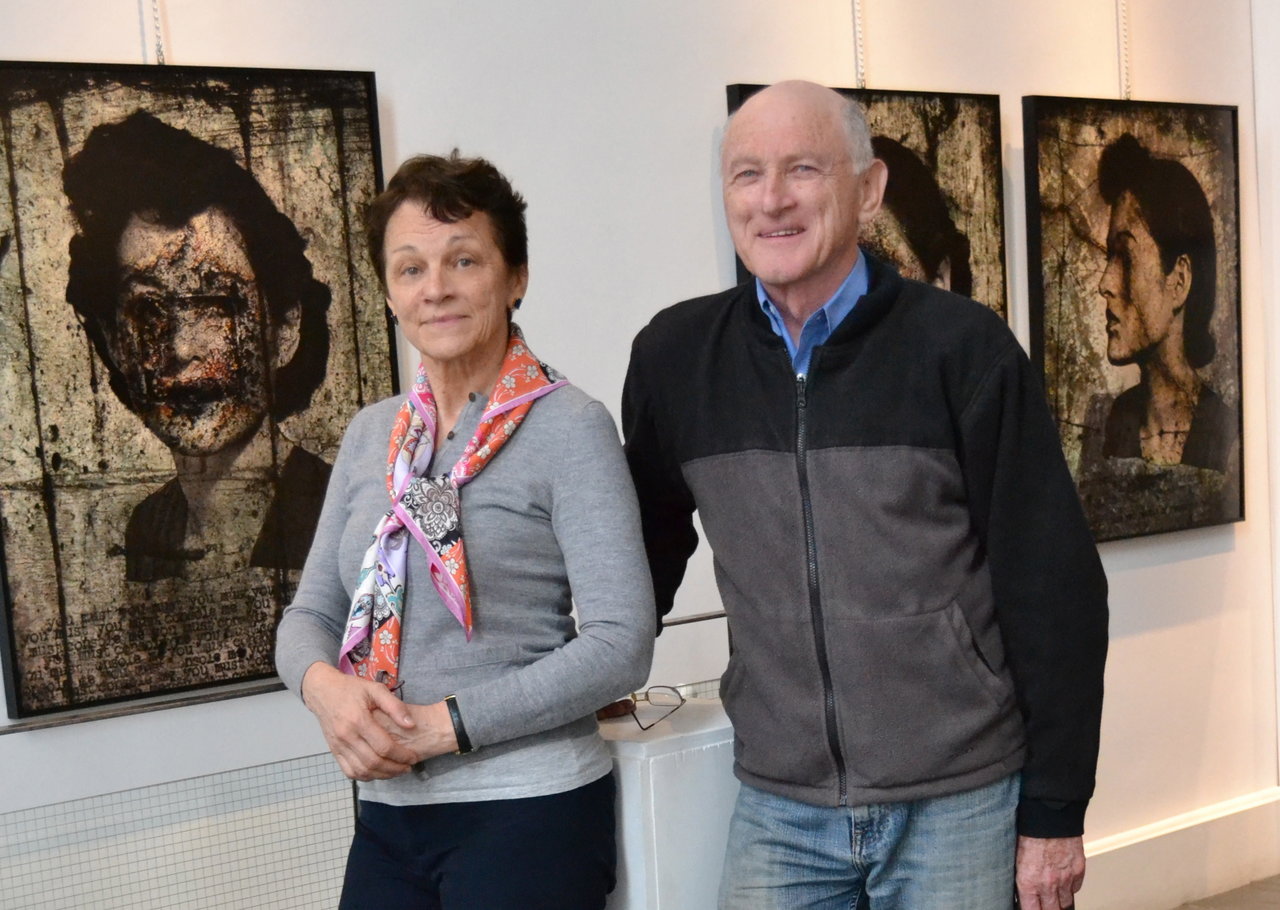 Csilla Csiki and Peter A. Por in front of Frank Rodick’s photographs, May 2015
Csilla Csiki and Peter A. Por in front of Frank Rodick’s photographs, May 2015
Interview with Csilla Csiki (Cs.Cs) and Peter A. Por (P.A.P), owners of Articsók Gallery by Emese Krunák-Hajagos (E.K-H)
E. K-H: How did you meet and what made you decide to open a gallery together? I know Peter is an established sculptor, but artists don’t usually open galleries.
Cs. Cs: We met ten years ago ‘by chance’. We were both new graduates in the field of art as mature students. We shared similar cultural backgrounds and had a keen interest in pursuing a career in art. We both started collecting paintings and sculptures, and this connected us to the art community and to artists whose work we admired and appreciated.
In 2013 many great galleries in Toronto closed down and I thought that it created a vacuum. We had a foundation we relied on, since we were already connected to the art world, Peter as an artist, I as an agent and both of us as collectors. It was my idea to open a gallery and Peter went along with the plan. Some people supported us but most of our friends questioned our sanity, saying “you are f…… nuts.” But we followed our passion. Opening a gallery was like a love story for us.
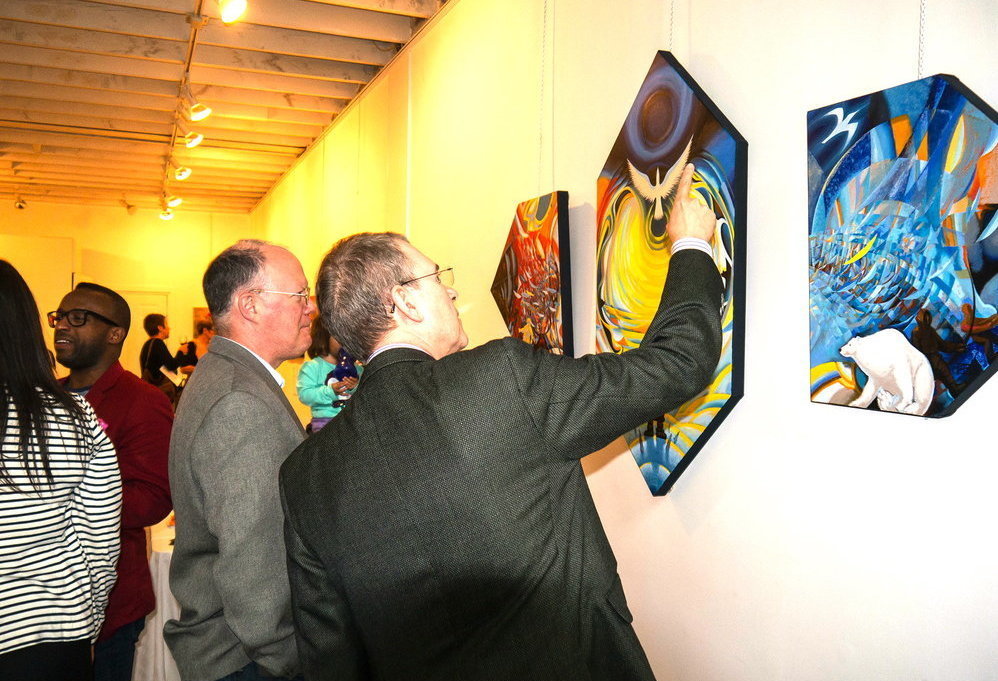 Northern Suite / Solo exhibition by Oleg Lipchenko, Opening Reception, Saturday, September 7, 2013. Photo: Shannon Litt
Northern Suite / Solo exhibition by Oleg Lipchenko, Opening Reception, Saturday, September 7, 2013. Photo: Shannon Litt
E.K-H: What does the name of the gallery, Articsók, mean and how did you come up with it?
P.A.P: We wanted a name that would be catchy, unusual and memorable.
Cs.CS: We were looking for a name that was meaningful for us and at the same time playful. The first part “art” is obvious to all, showing that our business is art. The second half “csók” comes from our mother tongue, Hungarian, and it means a passionate kiss—a kiss that lovers exchange. The name shows our passionate love for art. Artichoke is also a vegetable. So Articsók comes from a pun, a play on words. Peter often speaks, and even titles his work, in “pun-language” combining English, French and Hungarian words.
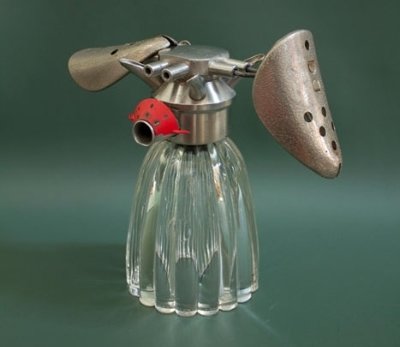 Peter Alexander Por, Doubleextra Virgin, 2007, mixed media, 10 x 10 x 6 inches. From the Metamorphosis exhibition, February 8 – March 8, 2014. Photo: Courtesy of Articsók Gallery
Peter Alexander Por, Doubleextra Virgin, 2007, mixed media, 10 x 10 x 6 inches. From the Metamorphosis exhibition, February 8 – March 8, 2014. Photo: Courtesy of Articsók Gallery
E.K-H: Please tell us more about yourself and your background.
Cs.Cs: I am an ethnic Hungarian from Romania, a culturally rich country with many different nationalities. Art was always part of my life and has surrounded me since my early years. Art, in its many forms: as historical architecture, as sculptures in public places, and as paintings in churches and museums, enriched my life and built up my “visual taste.” As far as I can remember I started to compare and contrast what I saw — you could say that art educated me. Art had an everlasting spell on me.
The “class” system still exists in Europe. In high school I fully understood why Van Gogh covered his face with charcoal and dressed in poor clothes when he painted The Potato Eaters. It is not easy to overcome boundaries and people are often singled out because of the color of their skin or their gender. I wanted to find a better place for my children. I arrived in Canada via Italy in the early 1980’s and continued to pursue my fascination for art, by earning a degree in Fine Art History from the University of Toronto, and then completing my studies at La Sorbonne, Paris in 2001.
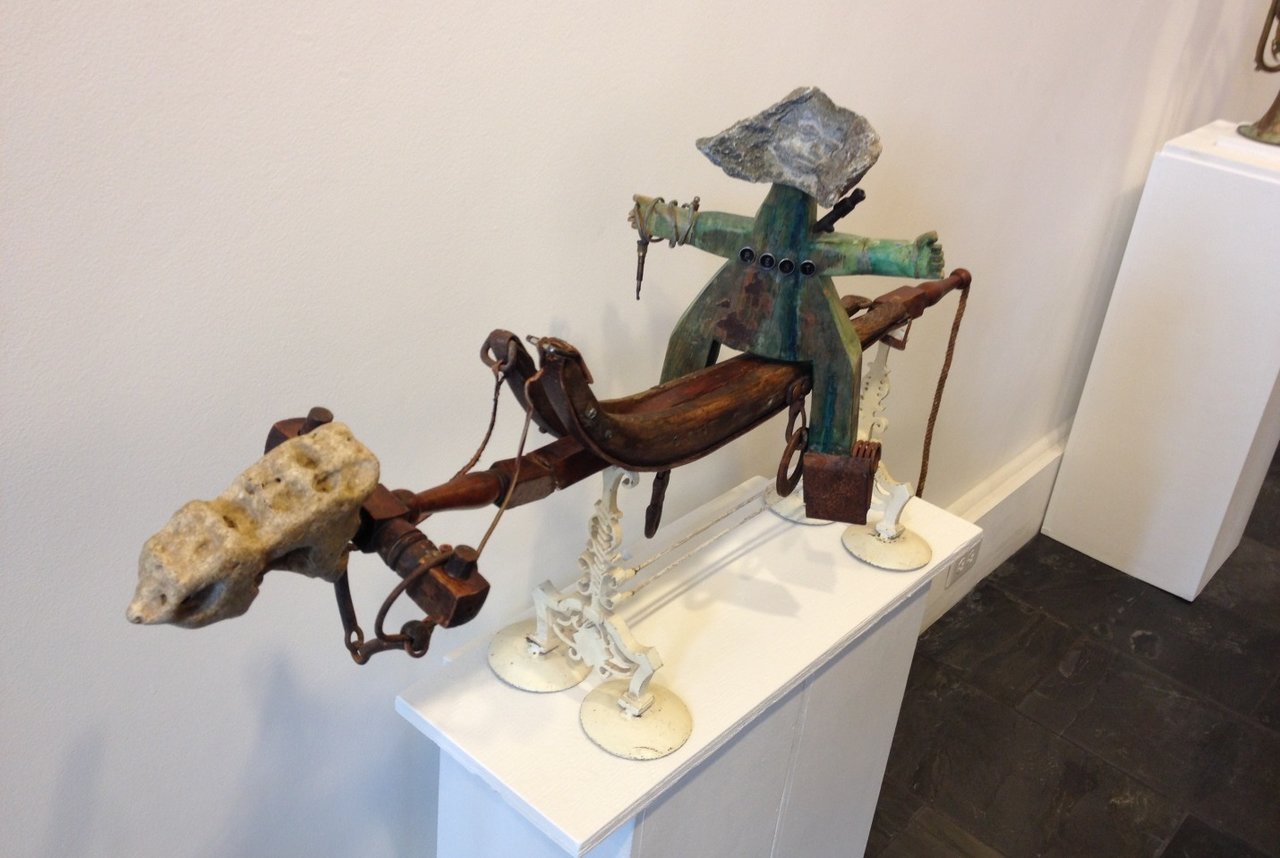 Andrew Pawlowski, The Rider of the Apocalypse 2 (Pest), 2012, mixed media, 22 x 40 x 2 inches. From the Metamorphosis exhibition, February 8 – March 8, 2014. Photo: Leanne Simaan
Andrew Pawlowski, The Rider of the Apocalypse 2 (Pest), 2012, mixed media, 22 x 40 x 2 inches. From the Metamorphosis exhibition, February 8 – March 8, 2014. Photo: Leanne Simaan
P.A.P: I left Budapest with my family in the uprising in 1956 for Chicago where I completed my degree in Architecture, and ended up in Toronto in 1969 because of the Vietnam War. Working in the architectural / construction field did not offer a creative outlet and I started exhibiting my sculptures in 1971. In the recession of the early 1990’s I decided to pursue a degree in Sculpture at York University. Since then I’ve had numerous solo shows, participated in many group exhibitions and I am also a member of the Sculptors Society of Canada.
E.K-H: Why did you choose this location, 1697 St. Clair West?
Cs.Cs: The location chose us. Peter owns this building; he developed the architectural design for the gallery and executed all of it with his own hands. He is a man of many talents.
P.A.P: There were no galleries around here and, as often happens after a gallery moves into a neighbourhood, the area slowly evolves into a cultural destination. The gallery attracts people from all over the city and as the neighbourhood started to change, more and more locals became aware of what we had to offer.
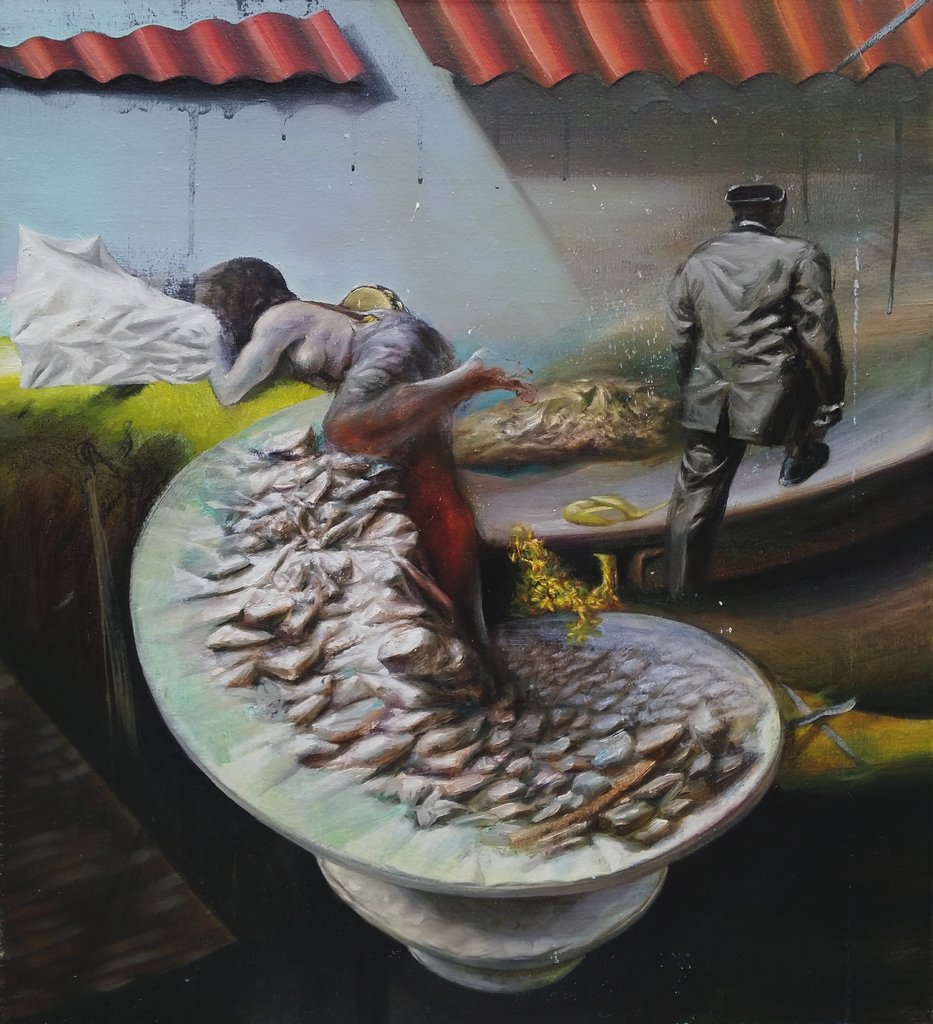 Jae-hong Ahn, The Buglers, 2014, oil on canvas, 54.5 x 60 cm. From the exhibition Jae-hong Ahn: Replaced Windows, November 13 – December 13, 2014. Photo: Courtesy of Articsók Gallery
Jae-hong Ahn, The Buglers, 2014, oil on canvas, 54.5 x 60 cm. From the exhibition Jae-hong Ahn: Replaced Windows, November 13 – December 13, 2014. Photo: Courtesy of Articsók Gallery
E.K-H: Your current exhibition and some others are group shows. Do you choose the theme and then select the artists, or the other way around?
Cs.Cs: The answer is “both.” There are exhibitions with preconceived ideas regarding their themes. Ubuntu, for example, was a tribute to Nelson Mandela and included local artists in addition to our group of artists who expressed an interest in the subject. Another example was our Metamorphosis show that we built around three of our artists: David Cumming, Andrew Pawlowski, and Peter A. Por who specialize in creating art from found objects. The works of artists in our current exhibition Inspirazione Divino, however, were selected based on the convergence of their style, subject matter and their impeccable technical ability.
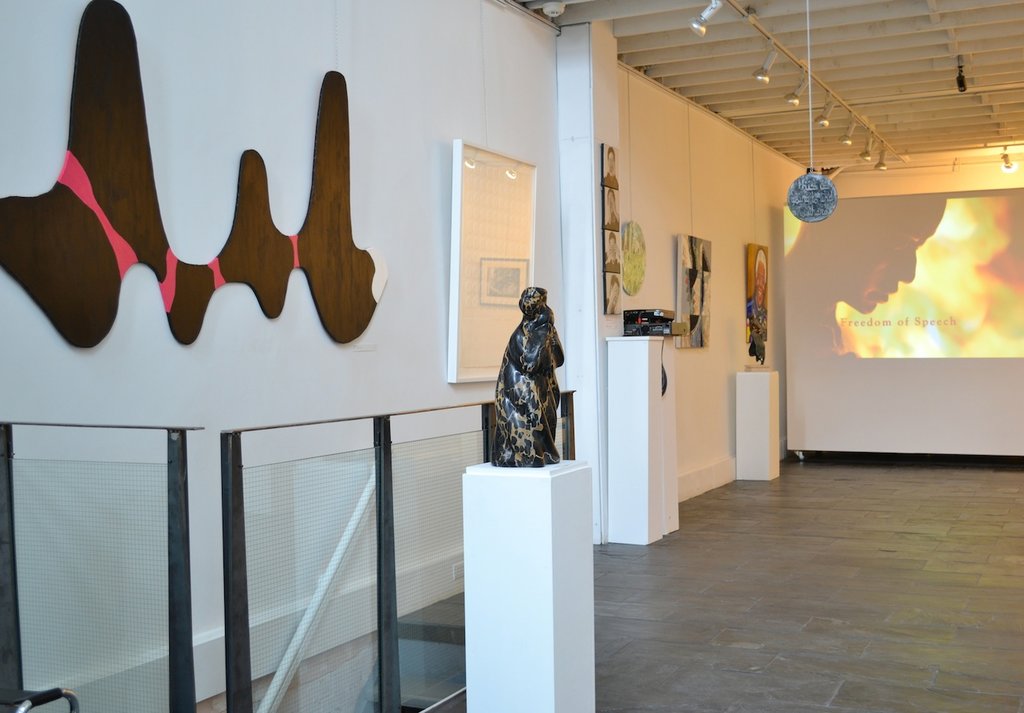 Installation view of the Group Show: UBUNTU, May 1 – June 14, 2014. Photo: Courtesy of Articsók Gallery
Installation view of the Group Show: UBUNTU, May 1 – June 14, 2014. Photo: Courtesy of Articsók Gallery
E.K-H: You have an interesting variety of artists with different backgrounds, styles and artistic mediums. How do you make decisions about who to represent or show at the gallery? Do you keep a close eye on the market and press, or go largely by intuition?
Cs.Cs: For at least the last 15 years, independently from each other, we have closely followed the art world in Toronto by attending exhibitions and art fairs throughout the city. In that pursuit we met artists, cultivated our interest in contemporary art in general, as well as in its innovative and progressive aspects. We familiarized ourselves with various styles and artistic mediums. So we do our research but at the end it is our trained eye and intuition that we rely on when choosing our artists. We have to fall in love with the artwork and deeply believe in the artists to commit ourselves to represent them.
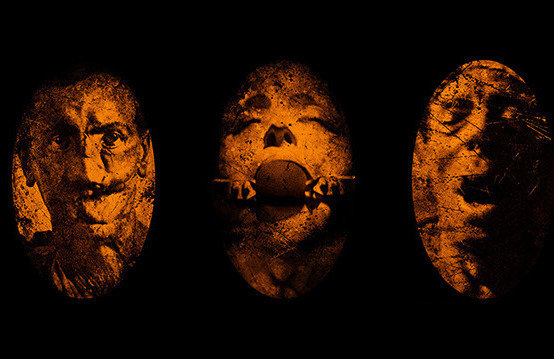 Frank Rodick, Three Studies for a Mouth (Explorations in statecraft, love, and the passing of woes), 2010, digital chromogenic print on metallic paper, 10.1 x 18.4 cm. From the exhibition Everything Will Be Forgotten by Frank Rodick, April 30 – May 31, 2015, as part of Scotiabank Contact Photography Festival. Photo: Courtesy of the artist and Articsók Gallery
Frank Rodick, Three Studies for a Mouth (Explorations in statecraft, love, and the passing of woes), 2010, digital chromogenic print on metallic paper, 10.1 x 18.4 cm. From the exhibition Everything Will Be Forgotten by Frank Rodick, April 30 – May 31, 2015, as part of Scotiabank Contact Photography Festival. Photo: Courtesy of the artist and Articsók Gallery
E.K-H: How does your gallery separate itself from other contemporary spaces in Toronto? What has been your greatest success thus far as gallery owners?
P.A.P: In my view our gallery is a large, bright, inviting and memorable space. We have received many compliments on the ambiance of the gallery. I also think that we stand out due to the quality of the work we represent. A number of our artists have been awarded major international grants and fellowships. We are very proud of their accomplishments and admire their effort.
The opening of Inspirazione Divino was the most successful since many visitors are returning to further engage with the canvases.
E.K-H: You just opened two years ago but when I was there on March 19th for the opening of your show, Inspirazione Divino, the gallery was packed to capacity or more. What is the secret of making a gallery this successful in such a short time?
P.A.P: The ‘secret’ is our commitment to, and our dedicated support of, our gifted artists from many cultural backgrounds.
Cs.Cs: I think the current show, Inspirazione Divino tells a lot about us. It means Divine Inspiration and we, with our European background believe in the immense power of creativity. I have always looked upon artists as having an extraordinary gift or talent that must be admired by others who don’t have it. The four artists, Joseph Cach, Ashley Johnson, Mahmoud Meraji and Marcelo Suaznabar, are very gifted. Their works are heavy with narratives that have a strong message. I still think that art has a social responsibility in addressing the problems of our time. I spent hours and hours looking at this exhibit. I almost lost myself in Joseph’s large painting, Presence of Light. Joseph went through several dramatic life-changing experiences which triggered him to paint a celestial light that shines through a wave of clouds. You can feel a presence of a higher power and its cleansing energy.
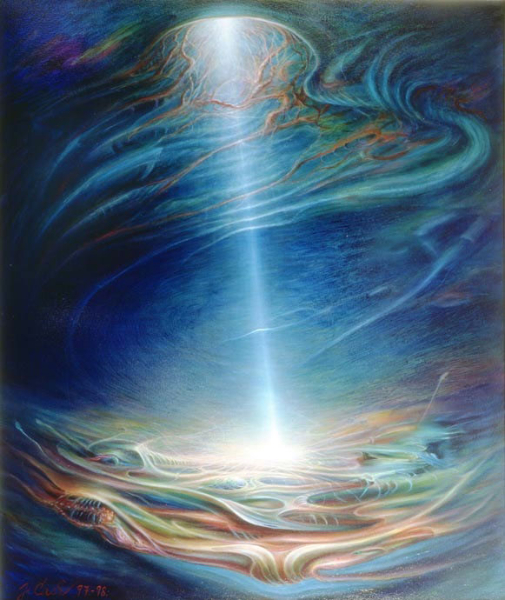 Joseph Cach, Presence of Light, oil on canvas, 48 x 40 inches. From the Group Exhibition: Ispirazione Divino, March 19 – April 25, 2015. Photo: Courtesy of Articsók Gallery
Joseph Cach, Presence of Light, oil on canvas, 48 x 40 inches. From the Group Exhibition: Ispirazione Divino, March 19 – April 25, 2015. Photo: Courtesy of Articsók Gallery
E.K-H: It seems to me that you changed the work on the walls. Ashley Johnson’s paintings dominate the show now. I call his work “magic realism” with its mixed images of animals and humans; showing the human in the beast and the beast in human. Why did you change the show?
P.A.P: I don’t really know. We had a number of his paintings in storage and one morning when I woke up and walked through the gallery I just felt the urge. He had a lecture in the gallery on Saturday (March 28) about losing identity, and the merging of the human and animal worlds. He was really nervous at the beginning but quickly loosened up. The gallery was packed and it was a very profound and interesting talk. Everyone enjoyed it and didn’t want to leave, asking Ashley for more and more. I think his paintings just get deeper in my mind, unconsciously, maybe. I am an artist, not a man of words. I just felt like hanging his paintings and looking at them. I will change it back to the original show before opening the doors tomorrow.
Cs.Cs: Suaznabar’s work also has that magic in them but is more on the playful side. Ashley’s canvases are more dramatic, more disturbing. Meraji depicts his divine characters in peace. I think the success of this show comes mainly from the quality of artwork; those different narratives and styles complement each other. Of course, we also used all the exposure that media and social media could provide us with to advertise the show.
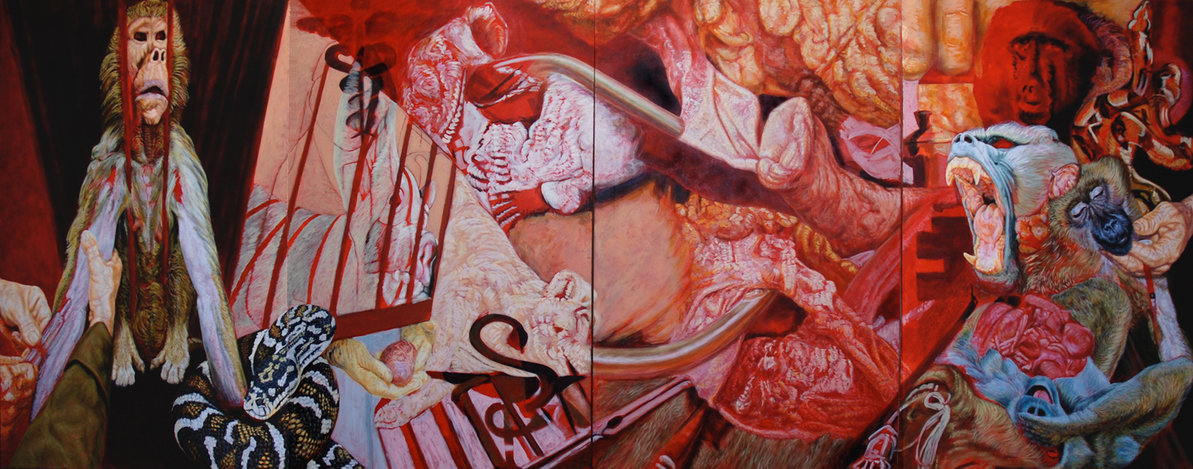 Ashley Johnson, Xenotransplant, 2011, acrylic on canvas, 67 x 172 inches. From the Group Exhibition: Ispirazione Divino, March 19 – April 25, 2015. Photo: Courtesy of Articsók Gallery
Ashley Johnson, Xenotransplant, 2011, acrylic on canvas, 67 x 172 inches. From the Group Exhibition: Ispirazione Divino, March 19 – April 25, 2015. Photo: Courtesy of Articsók Gallery
E.K-H: How did you build up your list of contacts and clients after opening the gallery? Are you satisfied with your sales as dealers?
P.A.P: We take an eclectic approach. Not all our sales happen in the gallery. We are pursuing opportunities in the corporate world and making incremental progress, nationally and internationally, in our number of sales.
Cs.Cs: When we opened the gallery we re-connected with the many like-minded people we met during the last ten years, people with whom we share common values. We both have a keen interest in human rights issues—race, class, gender, prejudice, religious equality, among others—and our mandate is to use art to represent those issues. Like our artists many of our clients are from different ethnic backgrounds. They are interested in art that has a strong expression as well as various artistic styles and mediums. We have many new clients from the neighbourhood as well. We want them to walk away with a piece they love, that is meaningful to them and which they enjoy looking at it for the rest of their lives. We also have a European trained master restoration specialist and that brings some people to the gallery too.
Establishing a gallery with excellent exhibitions that also sell well is a time-consuming procedure that requires patience, perseverance, hard work and dedication to art. I think we bring all those qualities. We love what we do.

Said it
All
You love what you do
I love what your doing!!!!!!